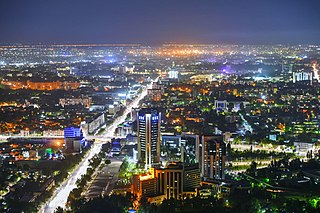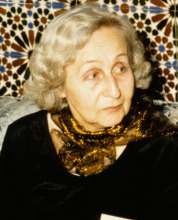The history of Turkmenistan is largely shrouded in mystery, its past since the arrival of Indo-European Iranian tribes around 2000 BC is often the starting point of the area's discernible history. Early tribes were nomadic or semi-nomadic due to the arid conditions of the region as the steppe culture in Central Asia was an extension of a larger Eurasian series of horse cultures which spanned the entire spectrum of language families including the Indo-Europeans and Turko-Mongol groups. Some of the known early Iranian tribes included the Massagatae, Scythians/Sakas, and early Soghdians. Turkmenistan was a passing point for numerous migrations and invasions by tribes which gravitated towards the settled regions of the south including ancient Mesopotamia, Elam, and the Indus Valley Civilization.

Tashkent, or Toshkent, is the capital and largest city of Uzbekistan, as well as the most populous city in ex-Soviet Central Asia, with a population in 2018 of 2,485,900. It is in northeastern Uzbekistan, near the border with Kazakhstan.

Nisa was an ancient settlement of the Parthians, located near the Bagyr neighborhood of Ashgabat, Turkmenistan, 18 km southwest of the city center. Nisa is described by some as the first seat of the Arsacid Empire. It is traditionally assumed to have been founded by Arsaces I and was reputedly the royal residence of the Parthian kings, although it has not been established that the fortress at Nisa was either a royal residence or a mausoleum.

Muhammad Shaybani Khan, was an Uzbek leader who consolidated various Uzbek tribes and laid the foundations for their ascendance in Transoxiana and the establishment of the Khanate of Bukhara. He was a Shaybanid or descendant of Shiban, the fifth son of Jochi, Genghis Khan's eldest son. His father was Sheikh Haidar, son of Abu'l-Khayr Khan.

Shakhrisabz is a city in Qashqadaryo Region in southern Uzbekistan located approximately 80 km south of Samarkand with a population of 100,300 (2014). It is located at an altitude of 622 m. Historically known as Kesh or Kish, Shahrisabz was once a major city of Central Asia and was an important urban center of Sogdiana, a province of the Achaemenid Empire of Persia. It is primarily known today as the birthplace of 14th-century Turco-Mongol conqueror Timur.
Uzbekistan is a country with potential for an expanded tourism industry. Many of its Central Asian cities were main points of trade on the Silk Road, linking Eastern and Western civilizations. Today the museums of Uzbekistan store over two million artifacts, evidence of the unique historical, cultural and spiritual life of the Central Asian peoples that have lived in the region. Uzbekistan attracts tourists with its historical, archeological, architectural and natural treasures.

Architecture of Central Asia refers to the architectural styles of the numerous societies that have occupied Central Asia throughout history. These styles include Timurid architecture of the 14th and 15th centuries, Islamic-influenced Persian architecture and 20th century Soviet Modernism. Central Asia is an area that encompasses land from the Xinjiang Province of China in the East to the Caspian Sea in the West. The region is made up of the countries of Kazakhstan, Uzbekistan, Tajikistan, Kyrgyzstan, and Turkmenistan. The influence of Timurid Architecture can be recognised in numerous sites in Kazakhstan and Uzbekistan, whilst the influence of Persian Architecture is seen frequently in Uzbekistan and in some examples in Turkmenistan. Examples of Soviet Architecture can be found in Uzbekistan, Kazakhstan, Tajikistan and Kyrgyzstan.

National University of Uzbekistan (NUUz) is a public university located in Tashkent, Uzbekistan. NUUz is the oldest and largest university in Uzbekistan.

Tashkent State Technical University (TSTU) ( is one of the oldest universities of Uzbekistan. Currently, the university consists of 6 faculties, and prepares highly-skilled professionals in technical and engineering fields. For this year, it is estimated to run 56 departments with over 10 746 students, who are taught by 6 academicians of the Academy of Sciences of Uzbekistan, 74 doctors of sciences and 314 candidates of sciences.
The Tashkent Automobile and Road Construction Institute was established in Tashkent, Uzbekistan to cover the high demands for professionals in the transportation and automobile field.
The Alisher Navoi State Museum of Literature of the Academy of Sciences of Uzbekistan is a scientific-cultural, educational establishment which mainly focuses on collecting and researching the historical materials and objects which are related to Uzbekistan's history. The museum plays a role in the cultural development of young generations in Uzbekistan and it keeps various documents, manuscripts from the Middle Ages.
Uzbekistan and Oriental Music are related because the region exerted a significant influence in oriental music's development.
Dr.Guzel Maitdinova (Maytdinova) is a Eurasian geopolitician, ethnologist, historian and archeologist based in Tajikistan. She is a Professor of the Department of History and Theory of International Relations of Russian-Tajik (Slavic) University (RTSU), a Director of the Center of Geopolitical Studies of Russian-Tajik (Slavic) University, and an Executive Director of the Central Asian Expert Club 'Eurasian Development' in Dushanbe.
Ibraghim Muminov, also known as Ibraghim Muminovich Muminov, was an Uzbek intellectual and scholar. Founder of the philosophical school in Uzbekistan.

Galina Anatolevna Pugachenkova was a Soviet archaeologist and art historian, regarded as a founder of Uzbek archaeology and central to the progression of archaeology and art history under Soviet regimes.

Mikhail Stepanovich Andreev was a Russian-Uzbek and Soviet orientalist, cultural researcher of Central Asia, ethnographer, linguist, and archaeologist. He was initially supervised by Vladimir Nalivkin, and was the teacher of Olga Alexandrovna Sukhareva. He was a corresponding member of the Russian Academy of Sciences.
Vera Andreevna Bulatova [Вера Андреевна Булатова] was an Uzbek archaeologist, architectural historian and museologist. She authored over thirty works in her lifetime on the archaeology and history of Central Asia.
Svetlana Borisovna Lunina is an Uzbekistani archaeologist specialising in the study of ceramic material and painting techniques of Central Asian monuments. She was a professor at Tashkent State University.

Margarita Ivanovna Filanovich is a Soviet historian, archaeologist, and leader of a Tashkent archaeological expedition.
Abd al-Rahim Biy (1697-1733) - the second ruler from the Uzbek dynasty of Ming in the Kokand Khanate.









